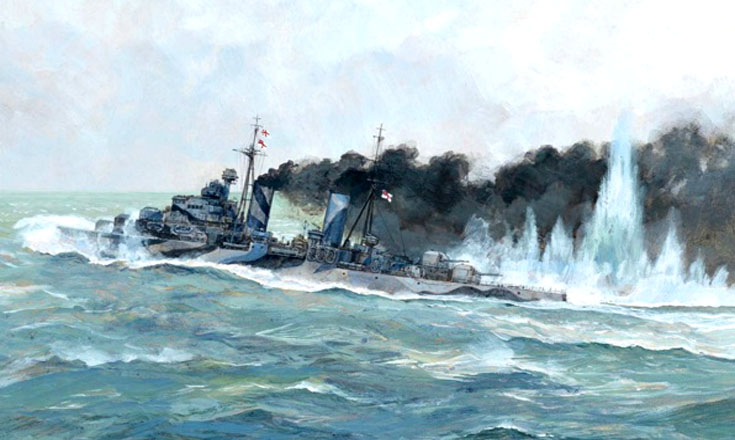
WWII Naval – Playing the Period
30th January 2000, Comments Off
Mare Nostrum

While this naval period doesn’t get as much play as it should, the great little ship models (from GHQ) make it something of a treat when they do appear on the tabletop. Several years ago I was writing figure reviews for the now defunct Osprey Military Journal, and the guys at GHQ sent me a bundle of ship models to critique. Well, they were fantastic, or at least they were after I’d covered my fingers in super-glue trying to stick on derricks and guns turrets! I landed up buying two fleets, one American (with a few Allies) and the other Japanese. I avoided the largely un-gameable carrier battles (that’s what computers are for), and concentrated on the battles fought off Guadalcanal. That meant building up fleets with a few battleships, a handful of cruisers and a whole bunch of destroyers. Every six months or so I pull these puppies out and have a game with them – it always looks good, and works really well as a multi-player game, with each player commanding a destroyer flotilla or cruiser division.

Recently though, I’ve abandoned the waters of the Pacific in favour of the Mediterranean. The American and Japanese fleets found a good home in Canada, but you can still see pictures of them here. Refighting the war in the Mediterranean means that I can command some of my favourite Second World War ships (Warspite, Eagle, Ajax etc.). The games are also small enough to allow the use of aircraft in limited numbers. This provision for aircraft is one of the real strengths of General Quarters 3rd edition (or GQ3) – using planes doesn’t necessarily slow down the game. Of course, I’m speaking about a few flights here, not a major carrier group worth of strike aircraft, or all those nasty Nazi Stukas of Fleigerkorps X. Better still, my wargaming buddy Dougie Trail is building up the opposition – the Italian Regia Marina.

Like WW2 land battles, the period seems to attract rules filled with statistics. The tendency is to cram naval rules with every possible piece of information, which can easily make a game unmanageable. I’ve tried so many naval rules over the years that I’ve lost count. For a while I favoured Command at Sea (produced by Clash of Arms), which had an elegant rules system and an information appendix the size of a New York phone book! Next came Warship by A&A, which worked – up to a point. I still haven’t found the perfect rules set yet – one than combines playability with accuracy, which is probably the unattainable Holy Grail of naval wargaming! The other problem is that this will never be a major period, so you want rules that are easy for people to pick up and use.
We also tried Stations Manned and Ready! which were the best of the bunch, despite the low production values of the rules. However, for the sake of simplicity we always went back to the tried and tested General Quarters set. They might have been overly simplistic, but at least they had the advantage than just about anyone can master the basics within a few minutes.
That said, we still wanted something with a bit more bit, and a slicker system, after all, General Quarters (1st edition) was more than 30 years old, and it showed in terms of both mechanisms and production values.

 Sample General Quarters (3rd edition) Ship Cards – They’re much nicer than the ones that come with the rules…
Sample General Quarters (3rd edition) Ship Cards – They’re much nicer than the ones that come with the rules…
General Quarters (3rd Edition)
 Then General Quarters (3rd edition) came out, so we began using it. I think 2nd edition was the First World War set. At first glance they seemed slightly more complicated than the original set, but we soon found that everything could pretty much be run from the playsheet. Things like better Japanese night vision and torpedoes, or superior American damage control and gunnery were all cunningly built into the statistics, leaving the players to get on with the game.
Then General Quarters (3rd edition) came out, so we began using it. I think 2nd edition was the First World War set. At first glance they seemed slightly more complicated than the original set, but we soon found that everything could pretty much be run from the playsheet. Things like better Japanese night vision and torpedoes, or superior American damage control and gunnery were all cunningly built into the statistics, leaving the players to get on with the game.
While the rules themselves are an intimidating 170 pages long, we soon discovered that over half was statistics, playsheets and such-like – stuff you won’t really need during a game. Of the rest, just under 50 pages contain all the rules (and of those you can leave out the air and submarine sections for most games), while the rest is a campaign system. That means the rules themselves are actually quite short and playable. As I said, most of the information is already built into the system.
We’re still getting used to the system – its radically different from the older simplistic version of General Quarters – but the rules are very slick. After all, Gill & Harms have done all the hard work, which means the games are stripped of all the number-crunching you often associate with naval games. While some die-hard naval geeks out there might prefer something more complicated (and less playable), this system is perfect for us.
Of course, it did involve producing new ship cards, which now contain a schematic plan of the ship, showing where the turrets, torpedo mounts, aircraft and secondary guns are – a useful game tool when things start getting knocked out.


More General Quarters (3rd Edition) Ship Cards







